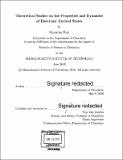Theoretical studies on the properties and dynamics of electronic excited states
Author(s)
Hait, Diptarka
DownloadFull printable version (7.274Mb)
Other Contributors
Massachusetts Institute of Technology. Department of Chemistry.
Advisor
Troy Van Voorhis.
Terms of use
Metadata
Show full item recordAbstract
Molecules are rarely found in electronic excited states under standard conditions but such states play a major role in chemical reactions. Computational prediction of properties of such states is hard with standard DFT protocols, as made evident by the failure of linear response TDDFT in predicting energies of charge-transfer excited states with semi-local functionals. Condensed phase dynamics of excited states are even more intractable on account of the computational cost scaling exponentially with the number of condensed phase particles under consideration. However, it is still possible to develop cheap but accurate approximations for properties and dynamics of excited states, and herein we describe some of the methods developed by us along those directions. We first demonstrate that restricted open shell Kohn-Sham (ROKS) calculations with semi-local hybrid functionals give good agreement with experimental absorption energies, emission energies, zero-zero transition energies and singlet-triplet gaps of CT states-unlike TDDFT, which significantly underestimates energy gaps. We then show that is possible to compute the effects of conical intersections on non-adiabatic dynamics of chemical systems by deriving perturbative memory kernels for the linear vibronic coupling model, and employing them to calculate the population dynamics of the Fe(II)-Fe(III) self-exchange reaction. Finally, we present a relationship between perturbation theory traces of the spin-boson model that allows us to obtain the exact solution with arbitrary initial harmonic bath state in the slow bath limit. We then attempt to generalize it to multiple states, and devise a similar trace relationship which makes it trivial to write down closed form expressions for populations and kernels to arbitrary order for any n level system.
Description
Thesis: S.B., Massachusetts Institute of Technology, Department of Chemistry, 2016. Cataloged from PDF version of thesis. Includes bibliographical references (pages 101-106).
Date issued
2016Department
Massachusetts Institute of Technology. Department of ChemistryPublisher
Massachusetts Institute of Technology
Keywords
Chemistry.